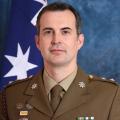Colonel Dave Beaumont, Director of the Australian Army Research Centre, introduces their new website and the improved Land Power Forum. Both form part of the Australian Army's growing PME Network.
It gives me great pleasure to introduce the new Australian Army Research Centre (AARC) website and the improved Land Power Forum. The AARC conducts and facilitates research on the employment and modernisation of the Australian Army, connecting and partnering with other militaries, industry, academia and Government. You may be familiar with the products of this research; the Australian Army Journal, Occasional Papers, Seminars and a range of events. These are important ways through which the Army’s future is described and chartered. However, I’d like to take this opportunity to focus upon the Land Power Forum.
What is the Land Power Forum, and why does the Army need it? The forum, now six years old, exists to sustain a conversation about the Army and its future. It is a place for the stakeholders of this future to offer their perspectives, whether they be serving military personnel, civilian officials, academics, members of industry and other partners invested in the Army’s growth as an institution. These perspectives may include discussion on topics extending from the theoretical to the immediately practical; from perspectives of the future characteristics of war to opinions on the Army’s organisation and purpose. It is a way in which the Army capitalises on the informed analysis and opinions of forum contributors, and a way in which Army communicates with the partners invested in its future successes. The Land Power Forum and other Army publications provide opportunities for people to present ideas that can be raised, discussed, dissected, and promoted.
Accelerated Warfare, a statement released in late 2018, stimulated thinking about the Army’s future. Accelerated Warfare highlights potential strategic threats (if they aren’t here already), the transformational impact of technology on society and warfare, and Army’s capability and capacity to operate in an increasingly integrated joint force. Adaptation, innovation and decision-making are critical in making Army ‘future-ready’ and capable against contemporary threats. Now the Army recognises that they are the same factors that ensure the Army can mobilise, scale, posture and respond to crises, contingencies and tasks that no-one had predicted. The Army has sustained a ‘contest of ideas’, ranging from the discussions of Chief of Army Seminar in 2018, and will be publicised in articles and commentary by the AARC in the future. Most importantly, the ideas that rose in this mix have been bound into the Army's strategic documents, captured in Army in Motion: Army’s contribution to Defence strategy, and practically applied in transformational initiatives to Army training and capability development.
The initiatives underway are not a beginning, nor are they an end. Just as the Army’s circumstances are changing rapidly and in unforeseen directions, the response required to be both ‘ready now’ and ‘future ready’ will naturally shift with every one of these movements. The Army has always combined incremental change with wholesale reform when external and internal pressures demand it. Organisational change is not just inevitable, but entirely normal. Yet the expectation now is that the marriage between what the Army does well already, and the establishment of an environment to transform into the future, must quicken. The Army’s capacity to innovate will be reflected in its ability to offset against emerging organisational challenges or strategic threats, or respond to crises. Responding quickly, efficiently and effectively to an unforeseen strategic need will be a direct consequence of how the Army sets the environment for transformation right now.
What does ‘pulling the future towards us rather than wait for it’ mean? On one hand it encourages the Army and others to embrace what is already coming. On the other it encourages Army to create the future by exploiting opportunities before it. A pathway has been set through Army’s strategic plans, but there will always be a need to remain vigilant. New sources of advantage or risks to be mitigated must be identified, steps discussed and developed to respond, and requirements are gathered to respond. A culture of inquiry and critique must challenge preconceptions and cultural conveniences. This does not mean Army has to accurately predict the future; it does require the Army to apply thoughts towards capability and capacity, preparedness and posture, which give it the best chance to transform effectively when a trend becomes something more.
In the Land Power Forum, and on the Australian Army Research Centre’s new website, there is a means for prospective authors to place their ideas directly in the hands of those who are expected to lead preparations in the Army for the future. It is an opportunity for the Army’s soldiers and officers to collaborate with others in the Australian Defence Force and Department and Defence - as well as with industry, academia, research institutes and the Australian community - to produce the institution that the nation not only wants but needs. All have a stake in the creation of an Army that is well prepared for the challenges ahead. I encourage you to contribute here and assist Army to identify what no longer works as well as it should, the nature of the change in circumstances the Army faces, and what it must do, so that the Army has choices to respond to events rather than having events dictate the Army's agenda.









